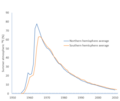Radiocarbon dating facts for kids

Radiocarbon dating, also called carbon dating or carbon-14 dating, is a cool way to figure out how old things are. It works for objects that used to be alive, like wood, bones, or plants. This method uses a special type of carbon called radiocarbon, which is slightly radioactive.
Contents
How Radiocarbon Dating Works
This amazing method was created in the late 1940s by Willard Libby at the University of Chicago. He even won a Nobel Prize in Chemistry for it in 1960!
Carbon-14 in Nature
Here's how it works:
- A special type of carbon, called 14C, is always being made in the Earth's air.
- This happens when cosmic rays from space hit nitrogen in the air.
- This new 14C then mixes with oxygen to form radioactive carbon dioxide.
- Plants take in this carbon dioxide through photosynthesis.
- Animals then get 14C by eating these plants. So, all living things have a tiny bit of 14C inside them.
Dating Dead Things
When a plant or animal dies, it stops taking in new carbon. From that moment on, the 14C inside it starts to slowly disappear. This happens because 14C is radioactive and breaks down over time.
- Scientists measure how much 14C is left in a sample, like a piece of old wood or a bone.
- The less 14C there is, the older the sample is.
- 14C has a "half-life" of about 5,730 years. This means that after 5,730 years, half of the 14C in a sample will have broken down.
- This method can reliably date objects up to about 50,000 years old. Sometimes, with special care, even older items can be dated.
Making Dating More Accurate
Since the 1960s, scientists have been working to make radiocarbon dating even more precise.
Calibration Curves
The amount of 14C in the air hasn't always been exactly the same. To fix this, scientists use a special tool called a calibration curve.
- This curve helps convert the measured 14C amount into a more exact calendar age.
- Think of it like a conversion chart that adjusts for past changes in the atmosphere.
Other Adjustments
Scientists also make other small corrections:
- Different types of living things can take in 14C slightly differently. This is called "fractionation."
- The amount of 14C can also vary in different parts of the world, or in different environments like the ocean. These are called "reservoir effects."
Human Impact on Carbon-14
Humans have also changed the amount of 14C in the air:
- Burning fossil fuels: When we burn coal and oil, we release old carbon that has almost no 14C left. This makes the amount of 14C in the air go down.
- Nuclear tests: In the 1950s and 1960s, above-ground nuclear tests released a lot of new 14C into the air. By 1965, the amount of 14C in the atmosphere had almost doubled!
How Scientists Measure Carbon-14
Originally, scientists used machines that counted the tiny bursts of energy (called beta radiation) given off by decaying 14C atoms.
- Today, a method called accelerator mass spectrometry (AMS) is used most often.
- AMS is much better because it counts every single 14C atom in a sample.
- This means scientists can use much smaller samples, like a single plant seed.
- It also gives results much faster.
Impact on Archaeology
Radiocarbon dating has changed archaeology in a huge way. It's often called the "radiocarbon revolution."
- It helps archaeologists date ancient sites more accurately than ever before.
- It also lets them compare the ages of events across different parts of the world.
- Thanks to radiocarbon dating, we now have a much clearer timeline for important moments in history. This includes the end of the last ice age and the start of the Neolithic (New Stone Age) and Bronze Age in different regions.
Images for kids
-
North Ronaldsay sheep on the beach in North Ronaldsay. In the winter, these sheep eat seaweed, which has a higher δ13C content than grass; samples from these sheep have a δ13C value of about −13‰, which is much higher than for sheep that feed on grasses.
See also
 In Spanish: Datación por radiocarbono para niños
In Spanish: Datación por radiocarbono para niños





